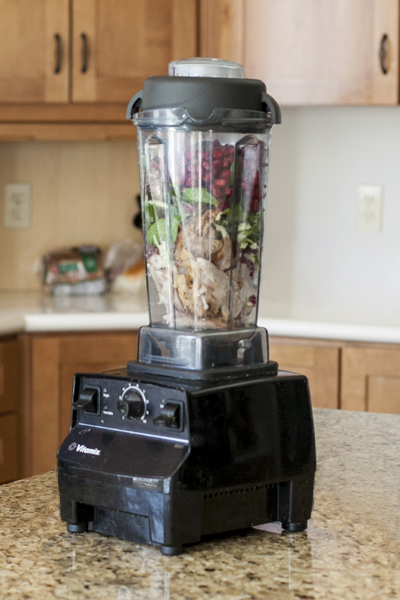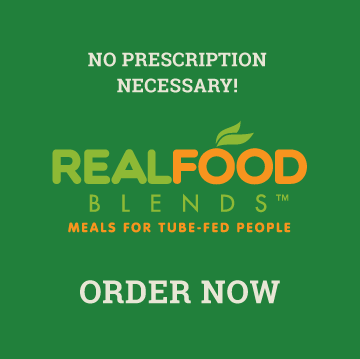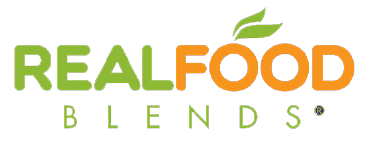
Blending real food and putting it through a feeding tube (a “blenderized diet”) is not a new concept. This is how tube-fed people were nourished before commercial formulas became popular in the 1970s. Now you may hear this concept called a “blenderized diet” or “pureed by feeding tube diet”. Whatever you call it, the basics are the same: putting real food to put through a feeding tube!
If you are already on a blenderized diet, hooray! You know the benefits of real food. We suggest using Real Food Blends meals when you’re traveling, at work or school, hospitalized or just don’t feel like putting all the work into a blenderized diet that day! They’re shelf-stable for three years so you can keep them around to have on hand when you need them.
Blenderized Diets for
Formula Users
If you are currently using tube feeding formula but are able to digest real foods, it’s best to ease into a blenderized diet. (This blog post by our dietitian gives great tips for transitioning to a blenderized diet via feeding tube.) Many people report positive changes when replacing even a few cans of formula with a blenderized diet.
Always discuss any changes to your nutrition with your dietitian or doctor, but most find that replacing one can of formula per day with a Real Food Blends meal is a good way to (re)introduce your body to real food and start a blenderized diet.
Blenderized Diet Research
When we first started on our blenderized diet journey, there wasn’t a lot of research available outside of anecdotal evidence. How times have changed! We have compiled a list of blenderized diet research and observational studies from medical professionals below, which may be of interest to anyone considering a blenderized diet:
Pureed by gastrostomy tube diet improves gagging and retching in children with fundoplication (blenderized diet with Nissan) (University of Cincinnati College of Medicine, 2011)
Conclusions: A PBGT diet is an effective means of providing nutrition to children with feeding disorders. In children post-fundoplication surgery, a PBGT diet may decrease gagging and retching behaviors.
The Use of Blenderized (Diet) Tube Feedings (2009)
Although this isn’t a study per se, this printed roundtable discussion of blenderized diets from medical professionals can be useful and give some ‘teeth’ to the blenderized diet anecdotes.
Nutritional Evaluation of a blenderized diet in five major burn patients
Conclusions: Five consecutively admitted major burn patients were successfully supported with a high calorie, high protein diet supplemented with a blenderized diet (formula) that was prepared in our hospital. It was effective in preventing significant weight loss and promoting wound healing and successful skin grafting.
Blenderized Tube Feeding Use in Adult Home Enteral Nutrition Patients: A Cross-Sectional Study (Mayo Clinic, 2015)
“Most common reasons for using BTF were as follows: it is more natural (43%), like eating what their family does (33%), and tolerate BTF better (30%). In patients who use BTF, 80% reported maintaining goal body weight. BTF resulted in significantly less reported nausea, vomiting, bloating, diarrhea, and constipation compared with commercial EN. Conclusions: This is the first study to evaluate BTF use in an adult HEN population. More than 50% of our patients used and approximately 80% expressed a desire to use BTF if provided with adequate information.”
Tolerance of Pureed Diet by Gastrosonomy Tube in Pediatric Patients, (Children’s Hospital of Michigan/Wayne State Medical School, presented at NASPGHAN, 2014)
Conclusion: The pureed diet by GT is an alternative diet that is well received by families of patients. The pureed diet can improve the gagging / retching, oral tolerance, weight velocities, and stooling habits. Adverse effects of the pureed diet are limited.
The BLEND Study: A Feasibility study looking at children transitioning onto blenderized tube feeds (The Sick Kids, presented at NASPGHAN, 2015)
Conclusion: Fewer subjects reported emesis and stools became firmer. Use of antacids, motility agents, and laxatives did NOT increase. 1.5 times more calories were required to maintain anthropometrics. Caregivers perception of BLEND was positive.
Short-Term Outcomes Using Blenderized Tube Feedings Among Gastrostomy-Tube Dependent Children (Children’s Hospital of Orange County, presented at NASPGHAN, 2015)
Conclusion: Pediatric patients who are dependent on gtube feedings may benefit from BTF for improvement in stool consistency, vomiting, and gtube intolerance. Full BTF may result in better outcomes than combination foods. Frequent monitoring of anthropometric measurements is warranted to promote age appropriate growth.







